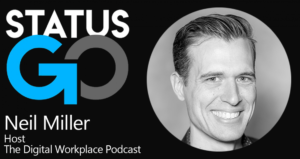In the pilot post N.C.I.S. Indianapolis – Pilot, Connectivity was defined as the confluence of Networks, Communication (and Collaboration), Information, and Systems: N.C.I.S.. Today, we explore Networks and their impact on Connectivity.
I don’t mean networks in the technology sense; I mean those internal and external, formal and informal networks that connect people together within a company and connect the same people to others outside the company.
 In his book, “The Future of Work,” Thomas Malone compares the transformation occurring in business today to the evolution societies have experienced. In antiquity, societies were made up of bands of people. They were very decentralized and unconnected. During the Middle Ages, kingdoms brought these bands under centralized control, but they were still largely unconnected from the central power. Democracies enabled society to decentralize and still remain connected.
In his book, “The Future of Work,” Thomas Malone compares the transformation occurring in business today to the evolution societies have experienced. In antiquity, societies were made up of bands of people. They were very decentralized and unconnected. During the Middle Ages, kingdoms brought these bands under centralized control, but they were still largely unconnected from the central power. Democracies enabled society to decentralize and still remain connected.
In the early 1900’s, businesses were small, local shops — again, decentralized and unconnected. By the middle of the century, large centralized corporations began to form. However, like kingdoms, the cost and difficulty of communication meant that many parts of these mega-corporations remained virtually unconnected. Today, with the birth of the Internet, communication costs continue to plummet and many of the barriers are eliminated, leading to organizations made up of complex networks of employees, partners and customers.
Authors Ori Brafman and Rod A. Beckstrom, in their book “The Spider and the Starfish,” postulate that the difference between a rigid, hierarchical organization and a more fluid, networked organization is analogous to a spider (hierarchical) and a starfish (network). When you cut off a spider’s head, it dies. A starfish does not have a head, so when you cut off one of its legs, it grows a new one (and, sometimes, forms a new starfish from the severed leg). Starfish organizations are more flexible, adaptable and resilient. There are incredible examples of starfish organizations: from the Apaches, to the modern-day Craigslist, Wikipedia and even Alcoholics Anonymous.
On the surface, Goodwill Indy appears to be made up of four very disparate business units: retail, commercial services, education and community initiatives. But when you dig a little deeper into the holistic services we provide to employees, students, mothers and their families, you can see how connected they truly are.
There may be a student in one of our schools that learns they are pregnant and in need of the type of support we provide through Nurse-Family Partnership. Or we may have a woman already being supported by NFP who needs a job to support her new family. With 51 retail locations and multiple commercial services sites, we can provide that employment opportunity. Or there may be a retail or commercial services employee who lacks a high school diploma and could benefit from the educational programs in our schools. Connections… linkages…
When you enlarge the circle to students’, employees’ and mothers’ families, friends and acquaintances, the impact of these holistic services expands exponentially.
Looking beyond our own services, we partner with many other individuals and organizations in central Indiana to provide a pathway out of poverty for those we serve. These connections strengthen our knowledge, abilities and services. They enable us to scale and be sustainable.
Next Up: Communication & Collaboration
If anything you read here or in other posts strikes a chord, I would love to hear from you. Leave a comment, hit me up on Twitter (@jtongici), find me on LinkedIn, or Google +.
 The Future of Work. A tantalizing topic technologists have pontificated about for years. In this episode of Status Go, I have a chance to chat with Neil Miller. Neil is the host of The Digital Workplace podcast. For those of you thinking this is about some future society…spoiler alert…the future is now and the digital workplace is happening before our eyes.
The Future of Work. A tantalizing topic technologists have pontificated about for years. In this episode of Status Go, I have a chance to chat with Neil Miller. Neil is the host of The Digital Workplace podcast. For those of you thinking this is about some future society…spoiler alert…the future is now and the digital workplace is happening before our eyes. 

 In his book, “The Future of Work,” Thomas Malone compares the transformation occurring in business today to the evolution societies have experienced. In antiquity, societies were made up of bands of people. They were very decentralized and unconnected. During the Middle Ages, kingdoms brought these bands under centralized control, but they were still largely unconnected from the central power. Democracies enabled society to decentralize and still remain connected.
In his book, “The Future of Work,” Thomas Malone compares the transformation occurring in business today to the evolution societies have experienced. In antiquity, societies were made up of bands of people. They were very decentralized and unconnected. During the Middle Ages, kingdoms brought these bands under centralized control, but they were still largely unconnected from the central power. Democracies enabled society to decentralize and still remain connected. organizations, mass collaboration, big data, the future of work, and some technology thrown in for good measure!
organizations, mass collaboration, big data, the future of work, and some technology thrown in for good measure!

